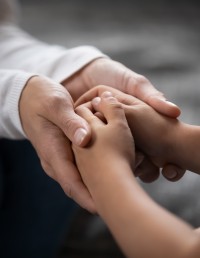David C. Lawsuit Transforms Utah’s Child Welfare System
In November 1991, a former Court Appointed Special Advocate (“CASA”) in Salt Lake City contacted NCYL with concerns about Utah’s child welfare system. More than a year of investigations and meetings with state officials followed. On February 25, 1993, seventeen children—represented by NCYL and co-counsel—sued the Governor of Utah and other state officials. The federal lawsuit, David C. v. Leavitt (later known as David C. v. Huntsman), sought lasting reform for Utah’s abused and neglected children. Over the course of David C.’s fifteen years, Utah’s child welfare system transformed from one of the most dismal and underfunded in the country into a model to be studied and emulated.
The facts that gave rise to the lawsuit were nothing short of a nightmare. David C., the lead plaintiff, entered foster care at age three along with his brothers. Nine months later, David witnessed their foster parent beat David’s older brother to death. When David and his younger brother were removed from the foster home, David had marks covering his entire body. Despite his post-traumatic stress disorder, David received virtually no therapy. The other lead plaintiffs in the case similarly alleged placement in unsafe and abusive foster homes, lack of mental health treatment, delays in investigating abuse and neglect reports, and more.
In May 1993, the court granted the plaintiffs’ motion to certify the case as a class action. The class included all children in Utah’s foster care system, as well as—over the defendants’ objection—children still living at home but who were reported as abused or neglected.
Settlement talks began soon after. On August 29, 1994, the court approved the parties’ proposed settlement agreement. The agreement contained ninety-three provisions addressing ten substantive areas that the defendants would need to complete over a four-year period. The settlement also established a three-member monitoring panel that would issue regular reports on the defendants’ progress. Over the next several years, the monitoring panel found persistent noncompliance with the settlement; in fact, conditions in Utah’s system were growing worse in certain areas.
In March 1997, in response to the plaintiffs’ enforcement motion, the court ordered the monitoring panel to create a comprehensive plan to address the defendants’ lack of progress. The panel enlisted outside assistance from the Child Welfare Policy and Practice Group, and the court agreed to give the defendants additional time to finalize this new plan. The resulting “Milestone Plan” was published in May 1999. In October 1999, the court issued an order retaining jurisdiction over the case and ordering the defendants to implement the Milestone Plan, with the Child Welfare Policy and Practice Group monitoring their progress.
The Milestone Plan included nine key milestones—containing 112 tasks in total—that Utah would need to meet to improve its child welfare system. The plan called for case process reviews of 900 cases to monitor whether certain practices were being performed. In addition, the quality of services would be analyzed through in-depth reviews of a small number of cases. The agency would form regional and state-wide quality improvement committees to incorporate stakeholder input. The Milestone Plan also called for the development of a practice model, with policies and training for staff, to ensure that reforms would reach front-line workers.
The next two years were tied up in litigation, as the defendants attempted to get out from under court oversight. In March 2001, the defendants lost their appeal of the district court’s October 1999 order. The Tenth Circuit Court of Appeals rejected the defendants’ argument that the district court exceeded its powers by extending the original four-year settlement term. The Tenth Circuit also rejected the defendants’ argument that the plaintiffs should have been able to foresee that the defendants would not comply with the settlement. The Tenth Circuit stated that “it would defy logic for [the plaintiffs] to agree to include the four-year Termination Provision in the Agreement if they actually foresaw that Utah would not be in substantial compliance with the terms of the Agreement at the end of the four-year period.”
In August 2002, in light of slow progress and recent state budget cuts, the plaintiffs filed another enforcement motion. In response, the court ordered the parties to work together to address the shortcomings in meeting the Milestone Plan. Over the next few years, the parties modified the Milestone Plan several times to ensure that needed improvements would occur, while also allowing flexibility to revisit those aspects of the plan that were proving unworkable.
Utah began making real progress under the Milestone Plan, assisted by new legal counsel on both sides and new agency leadership. In May 2007, the parties finalized an Agreement to Terminate the Lawsuit. It called for the defendants to run their system, without active oversight from a court monitor or plaintiffs’ counsel, for eighteen months. The Child Welfare Policy and Practice Group then conducted a final review, which showed the defendants’ compliance with the Milestone Plan. Based on these results, the plaintiffs agreed to final dismissal of the lawsuit on December 31, 2008. The defendants agreed to continue operating their system in accordance with the Milestone Plan until December 30, 2010.
By the case’s conclusion, NCYL had devoted more resources to the David C. case than it had to any other case up to that point. The payoff was well worth the effort. The transformation of Utah’s system impacted roughly 1,500 children in foster care at any given point and 10,000 to 15,000 children who were the subject of abuse and neglect reports each year. Utah had shown that it had the capacity and will to make these changes and to sustain them over time.
The improvements to Utah’s child welfare system could be seen both quantitatively and qualitatively. During the course of the lawsuit, the number of caseworkers more than doubled, from 282 to 612. Caseloads decreased to 13-15 cases per worker, down from an average of 19 cases. Where NCYL’s early investigations revealed that hundreds of foster children had not received regular medical check-ups, by the end of the lawsuit, 94% of children were receiving timely health assessments. The timeframes for conducting abuse and neglect investigations shortened drastically, with 96% of investigations occurring on time. Utah now had a state-of-the-art data management system, leading to greater transparency and accountability. Significantly, Utah dedicated meaningful funding to the reforms, increasing the child welfare budget from $50 million in 1993 to $151 million in 2007.
The plaintiff children were represented by NCYL and the law firms Morrison & Foerster LLP and Jones, Waldo, Holbrook & McDonough.





